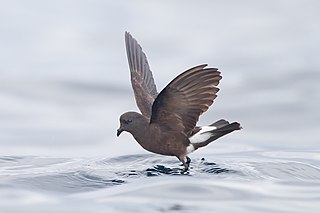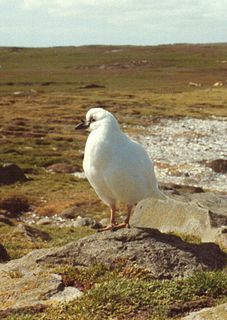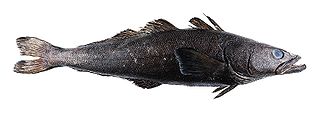 W
WThis is a list of the birds of Heard Island and the adjacent McDonald Islands in the southern Indian Ocean. For other animals there, see List of non-avian fauna of Heard Island and McDonald Islands.
 W
WThe black-browed albatross, also known as the black-browed mollymawk, is a large seabird of the albatross family Diomedeidae; it is the most widespread and common member of its family.
 W
WThe light-mantled albatross also known as the grey-mantled albatross or the light-mantled sooty albatross, is a small albatross in the genus Phoebetria, which it shares with the sooty albatross. The light-mantled albatross was first described as Phoebetria palpebrata by Johann Reinhold Forster, in 1785, based on a specimen from south of the Cape of Good Hope.
 W
WThe wandering albatross, snowy albatross, white-winged albatross or goonie is a large seabird from the family Diomedeidae, which has a circumpolar range in the Southern Ocean. It was the last species of albatross to be described, and was long considered the same species as the Tristan albatross and the Antipodean albatross. A few authors still consider them all subspecies of the same species. The SACC has a proposal on the table to split this species, and BirdLife International has already split it. Together with the Amsterdam albatross, it forms the wandering albatross species complex. The wandering albatross is one of the two largest members of the genus Diomedea, being similar in size to the southern royal albatross. It is one of the largest, best known, and most studied species of bird in the world, with it possessing the greatest known wingspan of any living bird. This is also one of the most far ranging birds. Some individual wandering albatrosses are known to circumnavigate the Southern Ocean three times, covering more than 120,000 km (75,000 mi), in one year.
 W
WThe Antarctic fur seal, is one of eight seals in the genus Arctocephalus, and one of nine fur seals in the subfamily Arctocephalinae. Despite what its name suggests, the Antarctic fur seal is mostly distributed in Subantarctic islands and its scientific name is thought to have come from the German vessel SMS Gazelle, which was the first to collect specimens of this species from Kerguelen Islands.
 W
WThe mackerel icefish is a benthopelagic fish found in the Southern Ocean and southernmost Atlantic Ocean. They are mainly to be found near Heard and McDonald Islands, Îles Kerguelen and islands in the south Atlantic such as South Georgia and Bouvet Island at depths of 0–700 metres (0–2,297 ft), but are commonly found at depths of 30 to 250 metres.
 W
WThe king penguin is the second largest species of penguin, smaller, but somewhat similar in appearance to the emperor penguin. There are two subspecies: A. p. patagonicus and A. p. halli; patagonicus is found in the South Atlantic and halli in the South Indian Ocean and at Macquarie Island.
 W
WThe leopard seal, also referred to as the sea leopard, is the second largest species of seal in the Antarctic. Its only natural predator is the killer whale. It feeds on a wide range of prey including cephalopods, other pinnipeds, krill, birds and fish. It is the only species in the genus Hydrurga. Its closest relatives are the Ross seal, the crabeater seal and the Weddell seal, which together are known as the tribe of Lobodontini seals. The name hydrurga means "water worker" and leptonyx is the Greek for "small clawed".
 W
WThe gentoo penguin is a penguin species in the genus Pygoscelis, most closely related to the Adélie penguin and the chinstrap penguin. The earliest scientific description was made in 1781 by Johann Reinhold Forster with a type locality in the Falkland Islands. They call in a variety of ways, but the most frequently heard is a loud trumpeting which the bird emits with its head thrown back.
 W
WThe macaroni penguin is a species of penguin found from the Subantarctic to the Antarctic Peninsula. One of six species of crested penguin, it is very closely related to the royal penguin, and some authorities consider the two to be a single species. It bears a distinctive yellow crest, and the face and upperparts are black and sharply delineated from the white underparts. Adults weigh on average 5.5 kg (12 lb) and are 70 cm (28 in) in length. The male and female are similar in appearance; the male is slightly larger and stronger with a relatively larger bill. Like all penguins, it is flightless, with a streamlined body and wings stiffened and flattened into flippers for a marine lifestyle.
 W
WThe eastern rockhopper penguin is a crested penguin with yellow crest feathers. It is a subspecies of the southern rockhopper penguin found in subantarctic regions and the Indian Ocean. It is one of the smallest crested penguins and has distinctive pink margins around its bill.
 W
WThe Cape petrel, also called the Cape pigeon, pintado petrel, or Cape fulmar, is a common seabird of the Southern Ocean from the family Procellariidae. It is the only member of the genus Daption, and is allied to the fulmarine petrels, and the giant petrels. They are extremely common seabirds with an estimated population of around 2 million.
 W
WThe Common diving-petrel , also known as the smaller diving-petrel or simply the diving-petrel, is a diving petrel, one of five very similar auk-like small petrels of the southern oceans. It is native to South Atlantic islands and islands of the subantarctic southern Indian Ocean, islands and islets off New Zealand and south-eastern Australian islands.
 W
WThe South Georgia diving petrel or Georgian diving-petrel is one of five very similar small auk-like diving petrels of the southern oceans. It is native to the South Atlantic and islands of the southern Indian Ocean and south-eastern Australia.
 W
WWilson's storm petrel, also known as Wilson's petrel, is a small seabird of the austral storm petrel family Oceanitidae. It is one of the most abundant bird species in the world and has a circumpolar distribution mainly in the seas of the southern hemisphere but extending northwards during the summer of the northern hemisphere. The world population has been estimated to be more than 50 million pairs. The name commemorates the Scottish-American ornithologist Alexander Wilson. The genus name Oceanites refers to the mythical Oceanids, the three thousand daughters of Tethys. The species name is from Latin oceanus, "ocean".
 W
WThe fulmar prion is a species of seabird in the family Procellariidae, found in the southern oceans.
 W
WThe marbled rockcod is a species of notothen native to the Southern Ocean, where it can be found at depths from 5 to 350 m. This is a commercially important species.
 W
WThe southern elephant seal is one of the two species of elephant seals. It is the largest member of the clade Pinnipedia and the order Carnivora, as well as the largest extant marine mammal that is not a cetacean. It gets its name from its massive size and the large proboscis of the adult male, which is used to produce very loud roars, especially during the breeding season. A bull southern elephant seal is about 40% heavier than a male northern elephant seal, more than twice as heavy as a male walrus, and 6–7 times heavier than the largest living terrestrial carnivorans, the polar bear and the Kodiak bear.
 W
WThe black-faced sheathbill, also known as the lesser sheathbill or paddy bird, is one of only two species of sheathbills, aberrant shorebirds which are terrestrial scavengers of subantarctic islands.
 W
WThe brown skua, also known as the Antarctic skua, subantarctic skua, southern great skua, southern skua, or hākoakoa (Māori), is a large seabird that breeds in the subantarctic and Antarctic zones and moves further north when not breeding. Its taxonomy is highly complex and a matter of dispute, with some splitting it into two or three species: Falkland skua, Tristan skua, and subantarctic skua. To further confuse, it hybridizes with both the south polar and Chilean skuas, and the entire group has been considered to be a subspecies of the great skua, a species otherwise restricted to the Northern Hemisphere.
 W
WThe subantarctic fur seal is found in the southern parts of the Indian, Pacific, and Atlantic Oceans. It was first described by Gray in 1872 from a specimen recovered in northern Australia—hence the inappropriate specific name tropicalis.
 W
WThe Antarctic tern is a seabird in the family Laridae. It ranges throughout the southern oceans and is found on small islands around Antarctica as well as on the shores of the mainland. Its diet consists primarily of small fish and crustaceans. It is very similar in appearance to the closely related Arctic tern, but it is stockier, and it is in its breeding plumage in the southern summer, when the Arctic tern has shed old feathers to get its non-breeding plumage. The Antarctic tern does not migrate like the Arctic tern does, but it can still be found on a very large range. This tern species is actually more closely related to the South American tern.
 W
WThe Patagonian toothfish is a species of notothen found in cold waters between depths of 45 and 3,850 m in the southern Atlantic, Pacific, and Indian Oceans and Southern Ocean on seamounts and continental shelves around most Subantarctic islands.